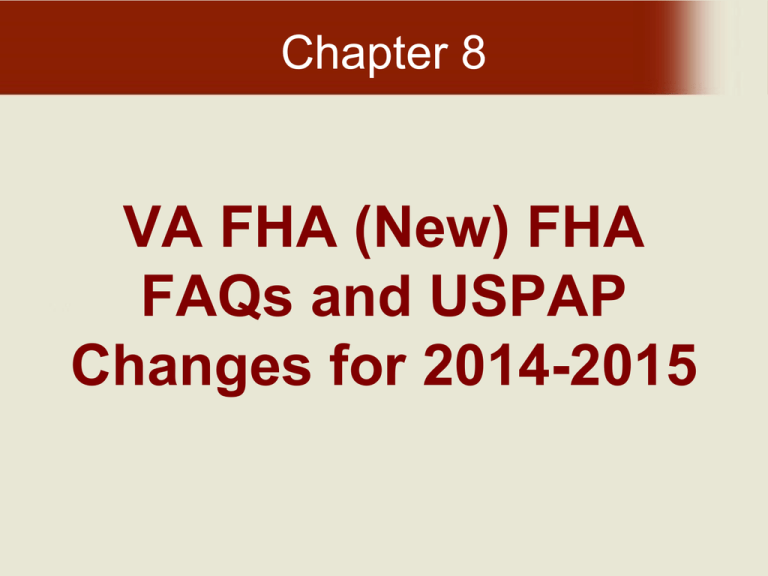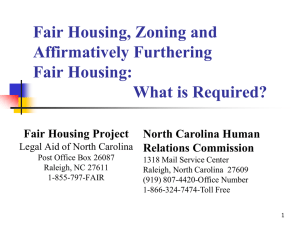FHA appraisals? - Hondros Learning
advertisement

Chapter 8 VA FHA (New) FHA FAQs and USPAP Changes for 2014-2015 Chapter 8: FHA FAQs and USPAP Changes Introduction • The following topics, questions and answers are taken from HUD’s FAQ on Valuation Protocol, as published by HUD on January 24, 2013. Today's FHA and VA 9/24/13 2 Chapter 8: FHA FAQs and USPAP Changes Key Terms • Compliance Inspection Report (CIR) A report to determine whether or not required repairs have been completed. • Homestead Lease Lease granted by the Department of Hawaiian Home Lands covering a one- to four-unit family residence located on Hawaiian homelands. • Streamlined (k) Program A program intended to facilitate uncomplicated rehabilitation and/or improvements to a home for which plans, consultants, engineers, and/or architects are not required. Today's FHA and VA 9/24/13 3 Chapter 8: FHA FAQs and USPAP Changes Key Terms • Termite Infestation Probability (TIP) Zones Zoning that provides a valuable resource for lenders to have familiarity with the geographic areas in which they process and underwrite loans. TIP zones are based on a copy of the International Residential Code map showing areas of termite infestation, prepared by the US Forest Service. • Tribal Trust Land A trust where land titles are reserved and held for Native American tribes and individual members. Today's FHA and VA 9/24/13 4 Chapter 8: FHA FAQs and USPAP Changes New Construction 1. What are the new construction documentation requirements for appraisers on properties 90% or more complete? Appendix D provides guidance for appraisers in the performance of FHA appraisals. In those cases involving new construction that is 90% or more complete, including existing properties less than one year old, the appraiser does not need the plans and specs to perform an appraisal. Today's FHA and VA 9/24/13 5 Chapter 8: FHA FAQs and USPAP Changes New Construction (cont.) 2. What are the new construction documentation requirements for lenders on new construction? The FHA has revised the list of architectural exhibits needed for single-family properties one year old or less. Per Mortgagee Letter 2006-33, lenders are not required to obtain, retain or submit to FHA construction plans and specifications, including: • Plot Plan • Floor Plan • Exterior Elevations, Sections, and Details • Specifications, Form HUD-92005 (Description of Materials) The FHA does require the submission and retention of the following documents for compliance review purposes: • Builder’s Certification of Plans, Specifications, and Site, Form HUD-92541 • Builder’s Warranty, Form HUD-92544 (on high ratio loans > 90%) • Building Permit and Certificate of Occupancy or 3 Compliance (continued) Today's FHA and VA 9/24/13 6 Chapter 8: FHA FAQs and USPAP Changes New Construction (cont.) 2. What are the new construction documentation requirements for lenders on new construction? (cont.) Inspections by an FHA Inspector (Footing, Framing, and Final) or 10-Year Warranty and a Final Inspection by an FHA Inspector (refer to ML 01-27) • Wood Infestation Report, NPMA 99a and 99b • Local Health Authority well water analysis or septic report, where applicable NOTE: If a property is 100% complete (existing construction less than one year old), the lender must obtain and retain the following documents: • Builder’s Certification of Plans, Specifications, and Site, Form HUD-92541 • Builder’s Warranty, Form HUD-92544 (on high ratio loans only) • Wood Infestation Report, NPMA 99a and 99b • Local Health Authority well water analysis or septic report, where applicable Today's FHA and VA 9/24/13 7 Chapter 8: FHA FAQs and USPAP Changes New Construction (cont.) 3. If the builder has gone out of business and no longer willing/able to sign the Builder’s Certification or Builder’s One Year Warranty and the foreclosing lender has a buyer who will rely upon FHA-insured financing to purchase the home, what documentation is required to be retained in the case binder? If the construction is completed and the lender has a Certificate of Occupancy or its equivalent, the home may be treated as existing construction for purposes of FHA documentation. Today's FHA and VA 9/24/13 8 Chapter 8: FHA FAQs and USPAP Changes New Construction (cont.) 4. When a property is, “Under construction, more than 90% complete with only minor finish work remaining,” the appraiser is instructed to condition the appraisal “Subject to the following Repairs or Alterations.” Who does the final inspection, an inspector or an appraiser? The final inspection may be completed by anyone the lender selects for those cases processed under the guidance of ML 01-27 (lender to certify); otherwise, the final inspection must be done by a FHA fee inspector. Today's FHA and VA 9/24/13 9 Chapter 8: FHA FAQs and USPAP Changes Wood Destroying Insects/Termites 5. Are termite reports for homes located in southern states still automatically required? The FHA no longer mandates automatic inspections for wood destroying insects or organisms in existing properties (over one year old). However, pest inspections are required if there is evidence of active infestation, if it is mandated by the state or local jurisdiction, if it is customary to the area, or at the lender’s discretion. Today's FHA and VA 9/24/13 10 Chapter 8: FHA FAQs and USPAP Changes Wood Destroying Insects/Termites (cont.) 6. Many areas of the country are termite prone. Does the appraiser address it on a form or does the underwriter call it out on the conditional commitment? The appraiser should report evidence of infestation in the “Improvements Section” of the appraisal report under “Foundation” by marking the evidence of infestation box. The box is checked if there is evidence of infestation. The FHA requires a clear pest inspection report on Wood Destroying Insects/Organisms only if there is evidence of active infestation, it is mandated by the state or local jurisdiction, is customary to the area, or at the lender’s discretion. Today's FHA and VA 9/24/13 11 Chapter 8: FHA FAQs and USPAP Changes Wood Destroying Insects/Termites (cont.) 7. Mortgagee Letter 2005-48 states that a termite inspection is no longer automatically required unless there is evidence of active infestation, it is mandated by the state or local jurisdiction, is customary to the area, or at the lender’s discretion. Can you provide more clarification of exactly how lenders should apply “customary to the area?” “Customary to the area” would be driven by local market practices such as incorporating provisions addressing termites in the standard real estate sales contract in termite prone areas, where the potential of infestation exists, or local requirements such as states requiring the use of their own wood destroying insects/organism form. Lenders may refer to the Termite Infestation Probability zone for this practice. The Termite Infestation Probability (TIP) zones allow lenders to develop familiarity with the geographic areas in which they process and underwrite loans. The TIP zones are based on a copy of the International Residential Code map showing areas of termite infestation, prepared by the US Forest Service. Today's FHA and VA 9/24/13 12 Chapter 8: FHA FAQs and USPAP Changes Wood Destroying Insects/Termites (cont.) 8. Will repairs that are now considered “minor” also be considered “minor” if listed on the termite report? Can the underwriter waive those conditions listed on the termite report to coincide with the URAR The appraiser will report what is readily observable during their visit to the property. Waiving any repairs noted on a termite report, which may or may not have been noted in the appraisal, should be evaluated on a case-by-case basis by the underwriter based on the nature and degree of deterioration noted in the termite report. Today's FHA and VA 9/24/13 13 Chapter 8: FHA FAQs and USPAP Changes Utilities—Well and Septic 9. Is the appraiser still required to report well, septic, and property line distances on an addendum to the URAR, or is this only required when problems are noted? How is the lender to determine if these distance requirements are met if the appraiser is not required to identify? The appraiser is not required to sketch the distances between the well and septic; but he should be mindful of FHA’s minimum distance requirements between private wells and sources of pollution (septic systems). If the appraisal notes a distance issue, or any adverse site conditions, that may warrant further inspections. It is the lender’s decision as to whether a qualified third party should map the distances and/or require testing for compliance with local or state requirements. The decision to require a test, certification or inspection, other than what is automatically required as noted in ML 2005-48, is made by the lender. Today's FHA and VA 9/24/13 14 Chapter 8: FHA FAQs and USPAP Changes Utilities—Well and Septic (cont.) 10.Is it mandatory for a well/septic report to show distance to lot lines? There is no standardized well/septic report and its contents would typically be determined by what is requested. If a lender determines that there is a need to confirm distances between well and septic systems, or lot lines, then the lender would specifically request that a qualified third party measure such distances. Today's FHA and VA 9/24/13 15 Chapter 8: FHA FAQs and USPAP Changes Utilities—Well and Septic (cont.) 11. If a water test is required, what tests are included? FHA requires tests (pre-2006) for five contaminants. If the local/state does not require testing of the five contaminants, can we just do what the state/local authorities require? For existing properties, the FHA will defer to the testing requirements of the local jurisdiction and will not add additional contaminant level testing. If the local authority does not have any requirements, the maximum contaminant levels established by the Environmental Protection Agency (EPA) apply. Today's FHA and VA 9/24/13 16 Chapter 8: FHA FAQs and USPAP Changes Utilities—Well and Septic (cont.) 12. Will the underwriter require a septic inspection when the property is vacant? Septic testing is to be governed by state or local requirements; however, the appraiser must note any readily observable deficiencies regarding the septic system and its surrounding area. If there are obvious signs of system failure, the appraiser is to “require inspection” to ensure that the system is in proper working order. In those instances where a subject property is vacant, the FHA defers to the underwriter to employ prudent underwriting in requiring any tests or certifications. Today's FHA and VA 9/24/13 17 Chapter 8: FHA FAQs and USPAP Changes Utilities—Well and Septic (cont.) 13. If hook-up to public water is available, must the homeowner do it? The appraiser is required to report on the availability of connection to public and/or community water/sewer systems. The lender is responsible for the determination of the feasibility for requiring connection. Today's FHA and VA 9/24/13 18 Chapter 8: FHA FAQs and USPAP Changes Utilities—Well and Septic (cont.) 14. How would shared well agreements be treated? Wells shared by up to four properties are acceptable provided that there is an acceptable legal agreement between the property owners, the quality of the water is found acceptable, there is sufficient capacity, and it is in accordance with local well codes. A shared well must have a shared well agreement and shall be binding upon signatory parties and their successors in title. Today's FHA and VA 9/24/13 19 Chapter 8: FHA FAQs and USPAP Changes Inspections and Certifications 15. It was stated that handrails and trip hazards are cosmetic. Wouldn’t these items be health and safety issues? The appraiser must always be mindful of health and safety issues and report what is readily observable. The missing handrails or trip hazards are property conditions that no longer require automatic repair for existing properties but should be reported by the appraiser. In these instances, lender discretion and prudent underwriting will determine whether or not a repair is advisable. Today's FHA and VA 9/24/13 20 Chapter 8: FHA FAQs and USPAP Changes Inspections and Certifications (cont.) 16. Are oil tank certifications still required for underground tanks with no evidence of surface contamination? The presence of an underground storage tank (UST) does not automatically trigger a certification. The appraiser is to note if there is any surface evidence of USTs. Further analysis or testing is required where the appraiser notes any readily observable surface evidence of leakage from a UST. If there is readily observable evidence of on-site contamination, the appraiser must make a requirement for further inspection in the site section of the report. The FHA defers to the underwriter to employ prudent underwriting in requiring any tests or certifications based on reported property conditions. Today's FHA and VA 9/24/13 21 Chapter 8: FHA FAQs and USPAP Changes Inspections and Certifications (cont.) 17.Are CIR’s still going to be used for verification that repairs have been completed? Since the appraiser is commenting on the condition of the property and the lender is the one calling for the repairs, please clarify what will be used for evidence that work has been completed? The Compliance Inspection Report (CIR), Form HUD-92051, will be used by the appraiser to report whether or not required repairs have been completed. If the lender required a repair as the result of an inspection or through information obtained other than the appraisal, the lender may use whatever they deem appropriate to document compliance with inspection or certification requirements. Today's FHA and VA 9/24/13 22 Chapter 8: FHA FAQs and USPAP Changes Inspections and Certifications (cont.) 18. Who completes a final inspection? Is a final required? Does the appraisal constitute a final? Will the lender’s certification on Form HUD-92900-A, page 3, suffice for a final inspection? If there is a building permit and CO, is a final required? The final inspection may be completed by anyone the lender selects for those cases processed under the guidance of ML 01-27 (lender to certify); otherwise the final inspection must be done by an FHA fee inspector. Under these scenarios the lender’s certification provided via Form HUD-92900-A would suffice as a final inspection. The appraisal may constitute a final for a newly constructed property that is 100% complete on the date the appraiser visits the property; however, page 3 of Form HUD-92900-A is still required to certify completion and compliance with HUD requirements and local building code. Today's FHA and VA 9/24/13 23 Chapter 8: FHA FAQs and USPAP Changes Inspections and Certifications (cont.) 19. Can you confirm my understanding as to whether or not the DE underwriter has the authority to waive cosmetic repairs if they are listed on the appraisal report? If so, does the DE underwriter need to fill out a specific form or just leave the repairs off of the Conditional Commitment? Please refer to Handbook 4155.2 Rev-1 (4.5, C.1.c) The DE underwriter may waive cosmetic or unnecessary repairs but not repairs to meet Minimum Property Standards or Minimum Property Requirements, which would include defective construction and conditions that impair the safety, security, or soundness of the dwelling. DE underwriters should document the reason for overriding a repair or an inspection that the appraisal is conditioned upon. Today's FHA and VA 9/24/13 24 Chapter 8: FHA FAQs and USPAP Changes Inspections and Certifications (cont.) 20. Noted lead-based paint still seems to be an issue that is unclear in the minds of some appraisers and lenders. Should the lender automatically call for painting only if the home is pre-1978, or should further measures be taken in all cases? Page 6 of Appendix D in Handbook 4150.2 states, “For any home built prior to 1978, check for evidence of defective paint surfaces, including peeling, scaling or chipping paint. For all FHA insured properties, correction is required to all defective paint surfaces in or on structures and/or property improvements built before January 1, 1978 in accordance with 24 CFR Part 35.” The appraiser is further instructed to provide a detailed description and identify the exact location of any deficiency under “physical deficiencies” affecting livability. The appraiser is required to condition the appraisal on the “repair” of any noted lead-based paint deficiencies. Today's FHA and VA 9/24/13 25 Chapter 8: FHA FAQs and USPAP Changes Inspections and Certifications (cont.) 21. Who can perform repairs when the appraiser noted defective paint in a home built prior to 1978 in view of EPA’s new lead-based paint Renovation, Repair and Remodeling Rule? On April 22, 2010, the EPA changed its requirements regarding renovation, repair, and painting for houses built prior to 1978 as follows: • Homeowners performing renovation, repair or painting work on their own home are exempt from the rule but are encouraged to learn to perform lead-safe work practices. • Property owners/landlords who renovate, repair, or prepare surfaces for painting in pre-1978 rental housing must be certified and follow lead-safe work practices required by the rule. • Contractors who perform the repair must be certified and must follow specific work practices to prevent lead contamination. Today's FHA and VA 9/24/13 26 Chapter 8: FHA FAQs and USPAP Changes Inspections and Certifications (cont.) 22. Who can inspect for completion of repairs when the appraiser noted defective paint in a home built prior to 1978 in view of EPA’s new lead-based paint Renovation, Repair and Remodeling Rule? FHA Roster appraisers and inspectors as well as other independent third parties may perform inspections to verify if painting repairs have been performed as required. These inspections are to determine completion of the repairs, not compliance with the Rule. Today's FHA and VA 9/24/13 27 Chapter 8: FHA FAQs and USPAP Changes Inspections and Certifications (cont.) 23. What is appropriate documentation to evidence compliance with EPA’s new lead-based paint rule? If the repair has been made by a contractor and/or property owner/landlord (if rental housing), the underwriter must be provided with a copy of the EPA or state-lead training certificate in the name of the party who performed the work. If the repair was made by the homeowner on their own home, the homeowner must provide the underwriter a letter stating that the homeowner made the repair and an inspection to verify completion of the repair is required. Today's FHA and VA 9/24/13 28 Chapter 8: FHA FAQs and USPAP Changes Inspections and Certifications (cont.) 24. Can the 1004D be used in lieu of form HUD-92051 for manufactured housing? No. Manufactured housing, whether new or existing, requires the use of HUD Form 92051. The 1004D Part B can be used only for existing site built construction (stick built or modular). Today's FHA and VA 9/24/13 29 Chapter 8: FHA FAQs and USPAP Changes Inspections and Certifications (cont.) 25. How should an empty or non-functioning in-ground swimming pool be treated? Does a swimming pool require perimeter fencing? At minimum, swimming pools must comply with all local ordinances (perimeter fencing, covers, etc.) and if empty or nonfunctioning, the pool must be secured by a cover that would be sufficiently sturdy to prevent a person from falling in the pool or through the cover. Non-functioning pools (and related equipment) which are not covered must be repaired. Swimming pools whose sides are unstable must be repaired or removed and the surrounding land re-graded. Today's FHA and VA 9/24/13 30 Chapter 8: FHA FAQs and USPAP Changes Cost Approach 26. When is the Cost Approach required for an FHA appraisal? The Cost Approach is required when the subject is a unique property, has specialized improvements, is new manufactured housing (initial sale from manufacturer), or the client requests the Cost Approach be completed. The square foot method is to be used and addressed in the Cost Approach section of the applicable appraisal reporting form. Today's FHA and VA 9/24/13 31 Chapter 8: FHA FAQs and USPAP Changes Cost Approach (cont.) 27. If an appraiser completes the Cost Approach, do they still use Form 1007 or has it too been eliminated? The Marshall & Swift Square Foot Appraisal Form, Form 1007, has not been eliminated. In those instances where the Cost Approach is used, the use of the applicable appraisal reporting form together with the guidance provided in Appendix D of Handbook 4150.2 is sufficient to produce an accurate and adequately supported Cost Approach. Form 1007 may be required for use by HOCs with jurisdictions with properties eligible for FHA-insured mortgages under: 1) HUD/FHA’s Section 248 program on Tribal Trust Land, a trust where land titles are reserved for Native American tribes and individual members. 2) HUD’s Office of Native American Program (HUD/ONAP) Section 184 on Tribal Trust, or 3) Homestead lease, which is a lease granted by the Department of Hawaiian Home Lands covering a one- to four-unit family residence located on Hawaiian homelands. Today's FHA and VA 9/24/13 32 Chapter 8: FHA FAQs and USPAP Changes Cost Approach (cont.) 28. Where does the appraiser insert Remaining Economic Life on the condo form to comply with FHA reporting requirements? It is to be entered in the Reconciliation section of the Form 1073 as a statement similar to that contained in the Cost Approach section of the other three FHA approved forms; i.e., “Estimated Remaining Economic Life ______ Years.” Today's FHA and VA 9/24/13 33 Chapter 8: FHA FAQs and USPAP Changes Accessory Dwelling Units 29. Can you please provide a definition of an accessory dwelling unit? An accessory dwelling unit (ADU) is defined as a habitable living unit added to, created within, or detached from a primary single-family dwelling and contained on one lot. ADU’s are commonly understood to be a separate additional living unit, including kitchen, sleeping, and bathroom facilities. ADU’s are subordinate in size, location, and appearance to the primary home and may or may not have separate means of ingress or egress. An attached unit contained within a single-family home, also known as a “mother-in-law,” or a “garage” apartment that may or may not be attached to the primary residence, is the most common type of accessory dwelling units. An accessory dwelling unit sometimes involves the renovation of a garage, basement, or a small addition to a primary residence. Today's FHA and VA 9/24/13 34 Chapter 8: FHA FAQs and USPAP Changes Accessory Dwelling Units (cont.) 30. If the accessory dwelling unit is on a separate electric meter, does it then become a two-unit property? An accessory dwelling unit may or may not have separate electrical service. The appraiser will make the determination of whether or not an ADU is a second dwelling unit utilizing the criteria stated above in FAQ #1. The FHA does not take the position that an appraiser should conclude that the presence of two electric meters necessarily constitute a two-unit dwelling structure and not an ADU. Today's FHA and VA 9/24/13 35 Chapter 8: FHA FAQs and USPAP Changes Accessory Dwelling Units (cont.) 31. The subject property is an up and down two-unit dwelling with common utilities. The top unit is rented. Do we have an accessory unit or a small income producing property? As described, it is a two-unit dwelling which would require the Form 1025, the Small Residential Income Property Appraisal Report. Today's FHA and VA 9/24/13 36 Chapter 8: FHA FAQs and USPAP Changes Manufactured Housing 32. If there is a manufactured home on the property, does it have to meet FHA standards if it is only used for storage or has a family member living in it, but is NOT paying rent? If the manufactured home being used for storage is not in compliance with FHA requirements, does not pose any safety issues by its presence on the property, is in compliance with the regulations of local jurisdiction, and is not functioning as a living unit, then the property could be eligible for FHA-insured financing, assuming all other site and property improvements are in compliance with FHA standards. If the appraiser places value on the manufactured home, the value can only be contributory value as a storage or accessory building and not as a living unit. If the manufactured home is used as a living unit and is not in compliance with FHA requirements, the property is not eligible for FHA-insured financing unless the manufactured home is removed. Today's FHA and VA 9/24/13 37 Chapter 8: FHA FAQs and USPAP Changes Two-Unit Properties 33. In Hawaii and Florida it is quite common to have twounit properties where there are two single-family (unattached) homes on one property. We have been told that HUD denies this type of property even though they have a high value. The FHA does accept two-unit properties comprised of two detached or unattached dwellings on one property provided it is a single real estate entity having a legal use. Today's FHA and VA 9/24/13 38 Chapter 8: FHA FAQs and USPAP Changes HECM Appraisals 34. Are HECM (Home Equity Conversion Mortgage) appraisals different from “regular” FHA appraisals? No. The appraisal reporting requirements are the same for the HECM as they are for regular FHA loans with the exception of pre-1978 homes that are security for a HECM and in which children under the age of seven will not be residing in the home. In these cases, the borrower can certify to the fact that no children under the age of seven reside in the home and the correction/repair of defective paint surfaces will not be required. Today's FHA and VA 9/24/13 39 Chapter 8: FHA FAQs and USPAP Changes Conditions and Repairs 35. If conditions or physical deficiencies are found, are repair estimates still required on all items? Repair estimates are required for those items that may represent a risk to the health and safety of the occupants and/or the soundness or structural integrity of the property. The appraiser must indicate the extent of repairs and note this in the appropriate section of the appraisal, in the “Additional Comments” section, or in an addendum. The estimated cost to cure is noted together with the required repairs. Today's FHA and VA 9/24/13 40 Chapter 8: FHA FAQs and USPAP Changes Private Road 36. Are private road maintenance agreements still required? The FHA is no longer requiring evidence of a joint maintenance agreement, recorded or otherwise, but still requires evidence of a permanent easement. The appraiser should ask if a maintenance agreement exists and comment on the condition of the private road or lane, especially if it is in inferior condition. Today's FHA and VA 9/24/13 41 Chapter 8: FHA FAQs and USPAP Changes Automatic Garage Doors 37. Please discuss the ongoing treatment of garage door openers that don’t reverse with pressure. What about the sensor beam that stops the door when something breaks down? The FHA no longer requires repair of a garage door opener; however, appraisers should be mindful that local requirements may require repair. Today's FHA and VA 9/24/13 42 Chapter 8: FHA FAQs and USPAP Changes Conditional Commitment 38. Does a new Conditional Commitment need to be completed when an appraisal is updated? No, a new Conditional Commitment only needs to be completed when a completely new second appraisal is provided. Today's FHA and VA 9/24/13 43 Chapter 8: FHA FAQs and USPAP Changes Reconsideration of Value 39. What is a reconsideration of value and who can request one? A reconsideration of value is a request to the FHA Roster appraiser to reconsider the analysis and conclusions of his or her appraisal based on information that was not presented on the appraisal report, but was relevant to the appraisal and available to the appraiser in the normal course of business as of the effective date of the appraisal. Only the lender’s underwriter can request a reconsideration of value from the FHA Roster appraiser. Today's FHA and VA 9/24/13 44 Chapter 8: FHA FAQs and USPAP Changes Reconsideration of Value (cont.) 40. In the course of reconsideration of value, what information can be presented to the appraiser? Information regarding comparable sales, listings or under contract of sale properties that the FHA Roster appraiser did not cite in the appraisal report but was available to the appraiser in the normal course of business as of the effective date of the appraisal is appropriate data to be provided to the appraiser. Today's FHA and VA 9/24/13 45 Chapter 8: FHA FAQs and USPAP Changes Reconsideration of Value (cont.) 41. Does the appraiser have to change the appraisal based on the “new” information? The FHA Roster appraiser is required to consider the data provided by the lender. The consideration may or may not result in an amended report. Today's FHA and VA 9/24/13 46 Chapter 8: FHA FAQs and USPAP Changes Reconsideration of Value (cont.) 42. If the reconsideration does not result in a value change can I order another consideration or appraisal? No. A reconsideration of value is the process of analyzing data not utilized in an appraisal report, regardless of whether the value is changed. The underwriter should include all relevant data with the request for the reconsideration. Today's FHA and VA 9/24/13 47 Chapter 8: FHA FAQs and USPAP Changes Reconsideration of Value (cont.) 43. Can the appraiser charge for the reconsideration of value? No. Since the information provided to the appraiser was available at the time of the appraisal, the appraiser should have been aware of it and either provided it in the original appraisal report or have analyzed it and decided not to provide it in the original report in which case the information should be in the appraiser’s file. Today's FHA and VA 9/24/13 48 Chapter 8: FHA FAQs and USPAP Changes Reconsideration of Value (cont.) 44. Can information regarding sales of properties after the effective date of the appraisal be used? The FHA does not accept retrospective appraisal reports for FHA–insured loans. The effective date of the appraisal must be the date the appraiser inspected the property. Comparable sales and other market activity that occurred after the effective date of the appraisal cannot be used by the underwriter when requesting a reconsideration of value. Today's FHA and VA 9/24/13 49 Chapter 8: FHA FAQs and USPAP Changes 203K/Mold Abatement 45. Can mold be abated using a Streamlined 203(k) loan? ML 05-50 contains a list of improvements that are permissible under the Streamline K: “The Streamlined (k) program is intended to facilitate uncomplicated rehabilitation and/or improvements to a home for which plans, consultants, engineers and/or architects are not required. The Streamlined (k) program includes the discretionary improvements and/or repairs shown below: • Repair/replacement of roofs, gutters and downspouts • Repair/replacement/upgrade of existing HVAC systems • Repair/replacement/upgrade of plumbing and electrical systems • Repair/replacement of flooring • Minor remodeling, which does not involve structural repairs • Painting, both exterior and interior • Weatherization, including storm windows and doors, insulation, weather stripping, etc. (continued) Today's FHA and VA 9/24/13 50 Chapter 8: FHA FAQs and USPAP Changes 203K/Mold Abatement (cont.) 45. Can mold be abated using a Streamlined 203(k) loan? (cont.) • • • • • Purchase and installation of appliances Accessibility improvements for persons with disabilities Lead-based paint stabilization or abatement of lead-based paint hazards Repair/replace/add exterior decks, patios, porches Basement finishing and remodeling, which does not involve structural repairs • Basement waterproofing • Window and door replacements and exterior wall re-siding • Septic system and/or well repair or replacement This list is not all-inclusive. Mold cleanup and repair/correction is typically considered uncomplicated and is acceptable as an eligible repair item for the Streamlined (k) program unless the magnitude of the mold requires rehabilitation for which plans and other specialists are required. Today's FHA and VA 9/24/13 51 Chapter 8: FHA FAQs and USPAP Changes Appraisal Portability 46. If the appraisal is transferred from one lender to another must the appraiser cooperate with the second lender? We encourage appraisers to cooperate with lender’s underwriters within the confines of USPAP. Appraisers must comply with all requirements of USPAP, including the confidentiality section of the Ethics Rule. This may require the second lender to obtain a release of liability from the first lender and provide it to the appraiser. Today's FHA and VA 9/24/13 52 Chapter 8: FHA FAQs and USPAP Changes Appraisal Portability (cont.) 47. Is the appraiser required to provide a copy of the appraisal to the second lender? No. The second lender must obtain the appraisal from the original lender. If the original lender is uncooperative with the new lender, the new lender should document the efforts made to obtain the appraisal in the case binder per the guidance offered in Mortgagee Letter 2009-29. Today's FHA and VA 9/24/13 53 Chapter 8: FHA FAQs and USPAP Changes Appraiser Trainees 48. What work can an appraiser trainee or licensee perform on an FHA appraisal? The FHA Roster appraiser is required to sign the appraisal and perform all parts of the analysis and reconciliation. A trainee or licensee may assist in any part of the appraisal but the opinions and analysis must be performed by the FHA Roster appraiser. The FHA Roster appraiser is required to select the comparables and perform all critical analyses contained in the appraisal report as well as the Market Conditions form. The FHA Roster appraiser must also inspect the subject property and at least the exterior of the comparable properties. A trainee or licensee may accompany the FHA Roster appraiser on the inspections but may not perform the inspections in place of the FHA Roster appraiser. Today's FHA and VA 9/24/13 54 Chapter 8: FHA FAQs and USPAP Changes 1004MC 49. Should data on the 1004MC mirror that in the Neighborhood section of the appraisal report? Not necessarily. The information on the 1004MC relates to properties that are comparable to the subject property and which a buyer may select as competitive properties. This reflects the subject’s micro market. The information in the Neighborhood section is broader and encompasses market activity in the subject’s macro market. Today's FHA and VA 9/24/13 55 Chapter 8: FHA FAQs and USPAP Changes Foreclosures, Short Sales as Comps 50. Can FHA Roster appraisers use foreclosures, short sales, and other distressed sales? FHA Roster appraisers must perform a neighborhood analysis to determine and identify the similarly influenced geographic area as the property appraised. The appraiser is responsible for selecting comparable sales and if foreclosure or short sales are prevalent, the appraiser must consider the impact these sales have on market conditions in making the decision to use a distressed sale. A foreclosure or short sale may have condition deficiencies that are not readily apparent. It is vital that the appraiser perform the necessary due diligence to understand the circumstances surrounding such sales and the impact upon the subject’s value and marketability. FHA Roster appraisers must fully explain and support the sales used in the appraisal report with a thorough analysis of market conditions, which include the types of sales found within the market. The appraiser should balance the analysis by using more than one sale type, if representational of the market, and contrast the differences of market impact between the sales in order to provide support for the report’s conclusions. Today's FHA and VA 9/24/13 56 Chapter 8: FHA FAQs and USPAP Changes Chapter 8 Quiz 1. You are assigned a new home as an appraisal assignment for an FHA loan. The builder has gone out of business. The home has a CO (Certificate of Occupancy).Which is correct? a. Because there is a CO, FHA allows you to treat this as existing construction. b. The borrower will need to obtain a private home warranty in order to obtain an FHA loan. c. The home is ineligible for FHA financing, because the builder has gone out of business. d. None of the above are correct. Today's FHA and VA 9/24/13 57 Chapter 8: FHA FAQs and USPAP Changes Chapter 8 Quiz 2. You are preparing an FHA appraisal on new construction, and the property is NOT located on Tribal Lands, nor in Hawaii. Which is correct? a. No Cost Approach is required. b. The use of the 1007 Marshall and Swift form is optional. c. You must utilize the 1007 Marshall and Swift form for the Cost Approach. d. Your regular reporting format should be sufficient to explain how you developed your Cost Approach. Today's FHA and VA 9/24/13 58 Chapter 8: FHA FAQs and USPAP Changes Chapter 8 Quiz 3. Which of the following statements is correct regarding wells and septic systems for FHA appraisals? a. The appraiser must note and report the availability of public water and sewer to the property. b. If the property is vacant, a septic inspection is mandatory. c. Well water must always be tested; the appraiser must sketch the site, showing the distances between the well, the septic system, and the lot lines. d. Well water tests are at the discretion of the lender; the appraiser must sketch the site, showing the distances between the well, the septic system, and the lot lines. Today's FHA and VA 9/24/13 59 Chapter 8: FHA FAQs and USPAP Changes Chapter 8 Quiz 4. Both the buyer and the real estate agent are unhappy with the results of your FHA appraisal. A reconsideration of value is sent to you by the lender, upon instructions from the underwriter. Which of the following is correct? a. b. c. d. If this reconsideration of value does not result in you changing your appraised value, the lender/underwriter may file another reconsideration of value. The information can include properties that have either closed or gone pending since the effective date of your appraisal. You must analyze the information given to you, determine if it was available to you at the time of your appraisal, in the normal course of business, and determine if this information would cause you to reconsider your value. You must change your value based on this information. Today's FHA and VA 9/24/13 60 Chapter 8: FHA FAQs and USPAP Changes Chapter 8 Quiz 5. You inspect a property built before 1978, and observe the following items. Which of these will require repair(s) under FHA guidelines? a. defective paint on the exterior of the attic windows b. a staircase with 13 steps and no handrail c. an unused, in-ground swimming pool, with dirty water and leaves collected in the bottom d. all of the above Today's FHA and VA 9/24/13 61 Chapter 8: FHA FAQs and USPAP Changes Chapter 8 Quiz 6. Which statement is correct about items which used to require automatic repair, but no longer do, such as missing handrails or trip hazards? a. Any steps without a handrail, no matter how few, still require an automatic repair. b. The appraiser should report missing handrails and trip hazards; lender discretion and prudent underwriting will determine whether or not a repair is advisable. c. The appraiser should report missing handrails and trip hazards; the decision to have them repaired is solely the appraiser’s decision. d. If the appraiser does not think the handrails require repairs, he/she need not report them. Today's FHA and VA 9/24/13 62 Chapter 8: FHA FAQs and USPAP Changes Chapter 8 Quiz 7. Which of the following is correct about inspections and certifications? a. All final inspections and certifications must be performed by the appraiser, and reported on the Compliance Inspection Report (CIR). b. Home inspectors must perform all Compliance Inspections and use the CIR form. c. If the case is processed under the guidance of ML 0127 (Lender to Certify), the final inspection may be completed by anyone the lender selects. d. If the final inspection is performed by someone other than the appraiser, he/she must still use the Compliance Inspection Report. Today's FHA and VA 9/24/13 63 Chapter 8: FHA FAQs and USPAP Changes Chapter 8 Quiz 8. If there is defective paint in a house built before 1978, which of the following individuals may complete the renovation, repair, and repainting without being certified in lead-safe practices? a. appraiser or home inspector only b. contractor only c. homeowner only d. property owner or landlord only Today's FHA and VA 9/24/13 64 Chapter 8: FHA FAQs and USPAP Changes Chapter 8 Quiz 9. Appraiser Joe inspects a property, which is a bi-level home. The lower level consists of two spaces: A garage plus an area that was once a beauty shop, which has been reconfigured into a living space for the owner’s mother. Based on the prior use, the lower level has separate electric and water meters. The zoning is residential, and allows “in-law” units and other second units which are “grandfathered in.” The owner tells you her mother pays her rent. Which is correct? a. b. c. d. The appraiser should write up the unit as a family room with a kitchenette, and make no mention of the mother, the unit, or the utilities. Because the mother pays rent, this is not an ADU, and does not qualify for a FHA mortgage. Because the utilities are separate, this is not an ADU, and the appraiser should stop and complete Form 1025, with a rent schedule. This fits the description of an Accessory Dwelling Unit; the appraiser should report what is there, and appraise the property as a single-family home with an ADU. Today's FHA and VA 9/24/13 65 Chapter 8: FHA FAQs and USPAP Changes Chapter 8 Quiz 10. Which loan allows the borrower to “opt out” of repair of defective paint in homes built before 1978, as long as the borrower stipulates that no children under seven will reside in the home? a. b. c. d. EEM mortgage EHLP mortgage FHA 203k HECM Today's FHA and VA 9/24/13 66 Chapter 8: FHA FAQs and USPAP Changes Chapter 8 Quiz 11. Which of the following is correct regarding FHA loans? a. The FHA no longer automatically requires repair of handrails if the appraiser does not think the lack of repair presents a safety issue. b. The FHA no longer requires evidence of a joint maintenance agreement for a shared private road. c. The FHA no longer requires repair of a garage door opener when the sensor beam that stops the door is broken. d. All of the above are correct. Today's FHA and VA 9/24/13 67 Chapter 8: FHA FAQs and USPAP Changes Chapter 8 Quiz 12. An FHA approved appraiser has an appraiser trainee working under her. Which of the following is the appraiser trainee prohibited from doing? a. accompanying the FHA appraiser on the initial inspection, and any repair inspections b. assisting in any part of the appraisal, as long as the opinions and analysis are performed by the FHA Roster appraiser c. signing the report d. none of the above Today's FHA and VA 9/24/13 68









